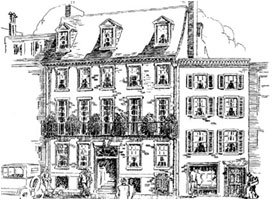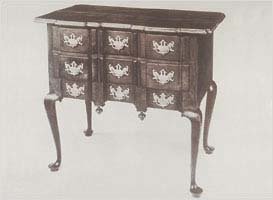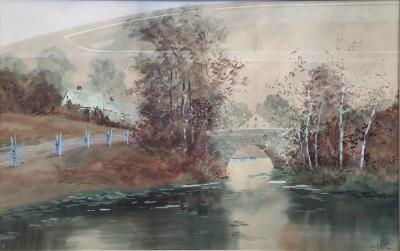A Short Biography of an Antiques Collector by Israel Sack
 |
We have reprinted this article that Israel Sack published in 1933 because the message it brings is as valid today as when Israel Sack published it. It demonstrates the value of selecting a qualified dealer and building a collection with his or her guidance. It also demonstrates that once one demands only authentic superior pieces, time proves the merit of this concentration.
An added benefit to this collecting goal is best summed up by the quote, “There is still another benefit to be derived from the collecting of antiques and that is the mental pleasure and satisfaction of discovery and ownership.”
We believe that the relationship and mutual trust between the dealer and collector adds a dimension to collecting that cannot be replaced.
— Albert M. Sack
A New England Connoisseur
The late Samuel Gelston King was born in Boston in the year 1857, the son of Franklin King and Sarah (Gelston) King. He went into his father’s business immediately upon leaving school, and continued an active interest in it, even at an advanced age walking daily from his Marlboro Street home to his offices on Atlantic Avenue, where, under the name of E. F. King & Co., his son, Gelston King, carries on for the third generation.
 | |
| 89 Charles Street, Boston, Massachusetts |
Samuel G. King was a familiar and well-liked figure in the conservative club circles of Boston. He was a member of the Union and the Exchange Clubs, and he also took part in the varied activities at the Country Club. His summer home was at Nahant, and he sailed under the pennant of the Beverly Yacht Club. Throughout his youth and later career he reflected in his many interests the best traditions of a New England heredity, so that it was not unusual that he should return his efforts to the collecting of fine American antiques.
When I first met Mr. King in 1912, all of the furniture in his Marlboro Street house was custom built by a very noted Boston firm of cabinetmakers. He first became interested in antiques through a visit to my place at 85 Charles Street, where a mahogany Hepplewhite sideboard caught his fancy. It was, indeed, a notable piece which I had picked up in Greenland, N.H., just outside Portsmouth; beautifully inlaid, finely designed, and soundly constructed. At that time he was not used to seeing furniture “in the rough,” that is, in the unrestored condition where the ancient shellac or varnish almost obscured the inlay underneath. Although he liked the sideboard, he hesitated, unable to decide whether to buy it or not. He came several times thereafter to look at it. On one of these occasions I happened to be out, but Mr. Hollis French (who even then was considered an outstanding authority on Americana) was also looking through my shop, and they met for the first time. In the conversation that ensued, Mr. French remarked that the sideboard was beautiful, and would be even more so when restored.
That seemed to make up Mr. King’s mind, for the next time I saw him he said, “Mr. Sack, what is your very best price for the sideboard?”
I answered that the very lowest for which I could sell the sideboard was $350.
“I would buy the sideboard,” he replied, “if I could dispose of the one I now have,” which, he went on to explain, had been made to order at the famous local firm of furniture makers.
“Would you accept it in trade for the antique?” he asked.
Anxious to make the sale, I said I would, if I liked the piece, be glad to make an allowance for it. It was on this occasion that I first went to Mr. King’s residence at 17 Marlboro Street. When I saw the sideboard, it was a great disappointment — although it was well made, it had no shape nor style to it. The vogue of reproducing old period pieces was not in style then. There was nothing for me to do but refuse to trade or make any allowance on it. I started for the door, Mr. King asked me what I thought he could do with the sideboard, and I jokingly advised him to make a present of it to somebody. He followed me and agreed to take my sideboard anyway, and I never did hear what finally became of the modern piece.
When the Hepplewhite sideboard was delivered to his home, Mrs. King and he were very much pleased with it, and from then on he became very much interested in antiques. I am proud to say that our friendship lasted until he passed away in 1932, at the age of 76. Mr. King spent a good deal of the latter years of his life gathering together a small but distinguished collection of antiques. He was one of those collectors who did not seek publicity; he hardly ever purchased anything without consulting me; and (like so many other leading connoisseurs) he never dickered on price. It is on this question of price, and the present and future cost of American antiques, that I feel the experience of Mr. King best illustrates the permanency of values.
 | |
| Lowboy, illustrated in Lockwood’s Colonial Furniture in America, that Sack sold in 1914 for $750 and repurchased in 1928 for $7,500. |
In 1914 I sold him a lowboy, which is illustrated in Lockwood’s “Colonial Furniture in America.” The price was $750. It was, up to that time, the most he had ever paid for an old piece, but he took my advice, and bought it. In 1928 I purchased the same lowboy from him for $7,500. In the same year (1914) I sold him a Sunflower Chest for $850–I brought a photograph of it to his office, and advised him to buy it. It was of the period around 1690 and he protested that he had no room for a chest of so early a style in his house. Nevertheless I suggested that he buy it and put it in the attic for a later date. He did buy it, paid for it on the spot, and did not come to see it for six weeks This was unusual, for he used to visit my place every day. I finally realized that he had a lot of faith in me and wanted to prove it. When he did bring the chest into his home he placed it in the hall.
After the close of the war, Mr. King came to me and told me he wished to dispose of the chest as it was the only early piece he had in the house, and therefore out of place among his other antiques. At that time he also wanted to furnish two homes for his sons who were returning from France. For that one chest, which was rare when I sold it to him, and still rarer when I repurchased it, I traded him enough antique furniture for both houses.
Illustrated on the frontispiece may be seen the drawing room of his Marlboro Street home, a picture of quiet and harmonious beauty in furnishings. The beautiful Queen Anne style maple highboy, with the burl maple veneer, was made in New Ipswich, New Hampshire, around 1720, and is one of the finest early pieces to have come out of that state. It was on exhibition at the Boston Museum of Fine Arts before I purchased it. In 1917 I sold it to Mr. King for $850. In 1928, I bought it back for $7,500; it is now in a private collection whose owner considers it one of the most distinguished of its period. The tallcase clock seen in the same illustration is a fine Simon Willard which originally came from Milton, Massachusetts, and which I sold to Mr. King in 1915 for $300. In 1930 I repurchased it for $2,000, and it now graces a prominent corner in the American Wing of the St. Louis Museum.
The only time that Mr. King did not take my advice, over a decade ago, was in not buying an 18th century blockfront secretary owned by the Waters family, and illustrated in Frances Clary Morse’s book. He could have bought it in 1918 for $1,800, but I could not get him up to that amount. Many times afterwards, he used to mention how much he regretted it. Well he might, for that blockfront desk was sold in 1927 for $15,000, and is now in the most famous collection in America.
Mr. King’s only venture into early silver was upon my recommendation that he purchase a Paul Revere water pitcher for $1,400. He had protested that he never bought old silver, and that it was outside of his province of collecting. “True,” I replied, “but if you take my advice you should own one fine piece like that.” He did, and many years later I bought it back for $4,500. This pitcher and the blockfront lowboy were later on display at the Park Square Building exhibition, and were the show pieces of the exhibition.
Considering that Mr. King had the use of these pieces for many years, and was then able to sell them for many times their original cost, I should consider fine antiques a reliable investment whichever way one looks at it. There is no doubt that the same conditions hold true at the present time. There is still another benefit to be derived from the collecting of antiques and that is the mental pleasure and satisfaction of discovery and ownership. I was made most happy when Mr. King’s daughter told me that during the final years of her late father’s life, after the passing of Mrs. King, the love and the collecting of American antiques kept him happy and interested in life.
He left behind him a notable group of early New England pieces, and a wellfounded reputation for being a discriminating judge of the fine and the beautiful as it was expressed in the tangible evidence of the work of our early craftsmen.
Israel Sack





























